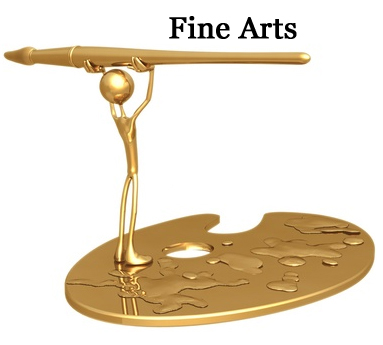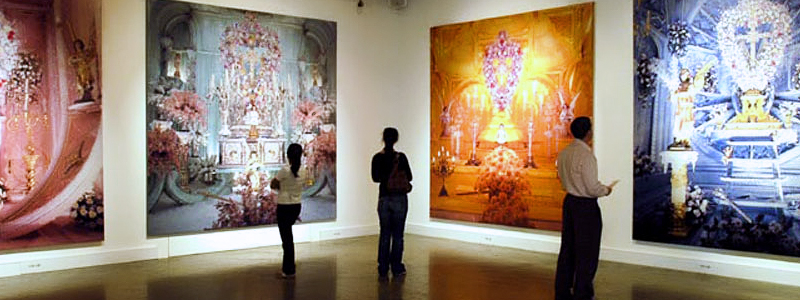Career in Fine Arts
 Creativity has always led to the discovery of something innovative in this world. Today, a career in creative art has become the latest trend among students. Many universities have started offering fine arts courses to students like you. Earlier, people believed that only science can help them to achieve great careers. However, in the middle of all this confusion with science, people soon realized that nothing is more satisfying than creative hunger.
Creativity has always led to the discovery of something innovative in this world. Today, a career in creative art has become the latest trend among students. Many universities have started offering fine arts courses to students like you. Earlier, people believed that only science can help them to achieve great careers. However, in the middle of all this confusion with science, people soon realized that nothing is more satisfying than creative hunger.
The Course Info
In most of the schools and colleges, you will find mainly five types of fine arts subjects. They are namely–
- Digital Art
- Art Theory
- Painting, photography and Drawing of sculptures
- Performing Arts
- Art history
For this, you need to acquire a basic degree of fine arts at school level. The degree will further help you in achieving better undergraduate fine arts degrees. Soon after graduation, you will be able to pursue your degree to the next level by applying for post graduation. The post graduate degree will help you to develop managerial skills along with refining your creativity. Your degree will depend upon the quality of the thesis that you present to your faculty of fine arts.
Career Path
The career is all related to art and creativity. If you manage to acquire good marks in your thesis, then you will be able to get a job as an art director in a gallery. The job requires a person to have both creative and managerial skills. You can also become an art buyer on behalf of museums and galleries. This job is 100 percent satisfying as it helps you to enjoy what you love.
You can also become a multimedia artist. Multimedia has become a rage nowadays. There are many options for you to embark in fine arts. You can run a theatre with your degree. In most of the courses, theatre has become a primary subject. You can also work as an independent artist by opening your own studio. Animation can also be regarded as a great career option. You can also become a graphic novel artist and publish your creativity to the world.
Online Degree Courses
Today, many schools and colleges have started providing online graduate degrees to the students. There are many universities, who have created huge web classes, where you will be able to interact with thousands of students regarding a particular topic. Just like a classroom, you will be able to listen to lectures of your professors, who will chat live with a microphone and a web cam.
The university websites will also provide you additional materials and notes on each subject. The online courses are quite helpful as it will help you to gain knowledge by not letting you to step outside the room.
So you want to be an artist… is this a realistic career choice, or are you going to live in a cockroach-infested flat for the rest of your life, fulfilling the “starving artist” stereotype? In short, the odds of being a successful fine artist (someone who makes a living by creating original, one-off pieces of art) are against you — but some people do succeed. Though most of us are exposed to art only as paintings in galleries, art teachers, and hobby painters, there are many other options out there. Being a fine artist isn’t the only career option for artists.
It’s often said that one must suffer for one’s art and, for aspiring artists, a spell of pennilessness after graduating has historically been de rigueur. This is as true today as ever, shown not only by the fact that 10.7% of 2008 fine art graduates were unemployed after leaving university (see graphic), but also by the high proportion listing catering or retail work as their primary occupation.
On the bright side, in between the waiting shifts you’ll have plenty of time to polish your artistic skills and cultivate a brooding sense of existential angst. Just remember to take the long view; while arts funding will be scarce in the coming years, recessions have historically allowed creativity to flourish, as fine art graduates of the late 80s and early 90s, such as Damien Hirst (pictured) showed.
As our data also shows, fine art graduates splinter off into a broad range of career directions, from teaching to management to media and advertising.
What skills have you gained?
First and foremost you should have begun accumulating a hefty portfolio of work with which to showcase your technical and creative talents. The theoretical side of your degree should enable you to put your work into proper context, explaining your influences, the reasoning behind your choice of subjects and why you used certain materials.
Art is often a solitary pursuit so you should also have a good idea of how to motivate yourself and research ideas, materials and equipment.
What jobs can you do?
“Fine art graduates often specialise in a particular form of art such as painting, drawing, installations, sculpture or printmaking but finding regular work or a permanent job as an artist is not easy and for some, self-employment, short-term residencies or commissions are the main career opportunities,” says Margaret Holbrough, careers adviser at Graduate Prospects. It can take time to establish yourself as an artist while building up a credible portfolio.
The creative arts sector has more to offer though and roles in art galleries and museums, theatre, film and crafts would be suited to fine art graduates.
Holbrough points out that in business, the artistic flair of fine art graduates is also recognised in roles where the visual image is paramount, such as advertising and marketing, exhibition design, publishing and illustrating.
“Teaching, art therapy and working for community arts projects offer more socially and educationally focused careers, plus arts administration and management would give an alternative perspective to the arts,” she says.
Postgraduate study?
More than 12% of 2008 fine art graduates went on to further study, many taking master’s courses to specialise in particular areas of art. Shorter courses specialising in certain related aptitudes, such as smithing, are also popular. A significant proportion go on to take a Postgraduate Certificate of Education, qualifying them to teach art in schools.
What Career Options are There for Artists?
A career in art is not limited to being a painter of canvases which get framed and sold in a gallery. Behind every piece of art in a newspaper, magazine, book, poster, and leaflet there’s a graphic or commercial artist — usually a team. There are graphic artists putting the magazines together, illustrators drawing the cartoons and graphics. Website designers, computer-graphic artists (computers don’t draw the graphics themselves, they’re just a tool, a modern version of a paint brush!), and animators. Film, TV, and stage set building. Computer games. Art galleries and museums. Teaching art and art therapy. Mural painting and face painting. Tattoo artist.
And think more broadly: photography, landscape design, interior design, shop-window design, framing. Textile and clothing design. Furniture and lighting design. Architecture and engineering. These all require creative skills and, even if in your heart you long to be a fine artist, working in any of these fields will complement what you do at your easel in your ‘own’ time.
Will I Really Make Enough Money to Live On From an Art Career?
The creative industry is competitive, but that’s symptomatic of the dedication people in it feel to their work. See it as a challenge to strive and succeed, rather than writing yourself off before you’ve even begun. It takes hard work and determination, the ability to sell yourself, and to produce the goods.
Art will not make you the same money as being, say, a stockbroker. But you have to decide what’s more important to you: money or having a job/career you thoroughly enjoy. Do you want a fancy car, or simply one that’ll get from A to B without breaking down? A designer top or using the money for a large tub of genuine cadmium red? Assess your priorities and make your choices accordingly. Do without rather than go into debt for a non-essential (and take a critical look at what you consider essential). When you’re 80 and look back on your life, what do you rather want be able to say: that you lived an interesting, creative life or that you lived in a huge house, had a new car regularly, and wish you’d found more time for your art?
Some people choose a job simply because it pays the bills and leaves them with plenty of time to pursue a fine-art career part time. Or one in an unrelated field so it won’t use up their creative energy. Only you can know if this is right for you. Personally I find being in a job I find dull, even for only a few hours a day, stifles my creativity. But balancing demanding, albeit creative jobs means I must work at ensuring I schedule enough painting time in the week.
What Qualifications Should You Get for an Art Career?
Take a look at all the options available at various fine art or a graphic art degrees/diplomas and choose the one that’ll give you the most options — you may think you know what you’re going to enjoy, but may end up being surprised by what you enjoy most. Take enough business courses to ensure you’ve the skills to sell yourself and your work, and can manage your own business (do the books, pay your taxes, understand a contract etc.). You need good language skills to present yourself and your work — e.g. could you write a good press release for your first show, compose a letter to a gallery without any grammatical or spelling errors? And make sure you can touch type — it saves a lot of time! If you can’t afford full-time college, do part-time courses rather than give up on the idea of an art career.
But I Want to Make a Career as a Fine Artist…!
It takes a lot of determination, hard work, hard selling, and persistence to make a career as a fine artist. You need to create paintings people want to buy. Are you willing to change your style and subject matter so that people will buy more? Will you take commissions, painting to order in terms of size, colour, and subject? Being a competent painter isn’t a magic wand. You also need to be able to market yourself and your work. It is possible to make a career as a fine artist, but it’s tough and few artists make a living by only selling their work (at least initially). But then who says you can do only one thing at a time?
FAQ’S
Q1.What the career of fine-arts hold for creative people ?
A1. Fine arts include drawing, painting and sculpture. These fields are each very expansive. Most artists choose to keep their talent alive but alongside take up another career, since there are very few options open where pure painting and sculpture work is concerned. Artists today wish to use their skills in other areas such as commercial art, which is relatively more popular. The use of art to express ideas or rather sell ‘ideas’ has long been used because in general, 85% of our thoughts and views are nurtured by what we ‘see’. Therefore, the use of art is definitely a valuable asset in today’s businesses.
A relatively new area – commercial art – is the application of the different types of art media for commercial purposes – such as creating advertisements, billboards, book jackets, window displays, cinema slides, technical catalogues, packaging etc. Someone joining this field would not only need to be a good artist but also be adept in the ‘art of marketing and publicity.
The Work Painting involves designing murals, portraits, sceneries using various types of medium and on different surfaces. Sculpting is creating statues, monuments by either chiseling stone or carving wood or handling clay. This is a highly involving and time-consuming task. Modern sculptors use materials like reinforced cement, concrete, white bronze or plaster of Paris, which all give amazing results. Some of the areas that utilise commercial art are:
Design – A designer is someone able to balance artistic talent and training with technical knowledge and business know-how, to meet the industry’s requirements. First priority is given to create something that reaches the commercial and technical standards rather than only being a good work of art. Designers work with people of different disciplines to reach this goal.
Graphics – This involves illustration coupled with photography, lettering, designing symbols and logos for companies etc. Entry into the Field Natural interest and talent needs to be enhanced with formal training since this helps foster and embellish the artistic skills. Secondly, being in contact with experts in the field, one gets to feel the pulse of the industry, learn about what the career is like, what is to be expected of them once enter the business world and so on.
Q2.What are the courses involved intraining for Fine-Arts?
A2. There are a large number of fine arts courses offered at the certificate, diploma and degree level at a number of institutions. The courses have become more challenging and diverse involving textile designing etc. making the career very inviting. Training in commercial art is given in various schools and is often associated with fine arts. The certificate diploma is of a varying duration of 1-5 years. Details of eligibility criteria for the various institutions.
Q3.What are the Personal Attributes ?
A3. One needs to really enjoy creating and imagining; this is one discipline where learning from others plays an important role in the growing process. One should know how to be radical in their ideas but be practical enough to create original, inspiring work.
Q4.What are the Career Prospects ?
A4. Art students have a large spectrum of options in front of them, ranging from working in art studios, advertising companies, publishing houses, fashion houses etc. A number of artists chose to be freelance workers; this allows for variety in their projects. Other related careers are teaching, direction, photography, television, clothing and fashion, as art directors for magazines, on-line services, software companies, publishing houses, manufacturers, advertising, promotion and product design.
Q5.What is remuneration ?
A5. This can vary depending on the jobs. Those designing magazine covers can start with a pay of Rs. 3,000 to Rs. 4,000 per month, with the senior level getting around Rs. 10,000 – Rs. 11,000 every month. Freelance artists can be paid anything from Rs. 2,500 to 15,000. All one need to do is look around – there are endless things one can find.















